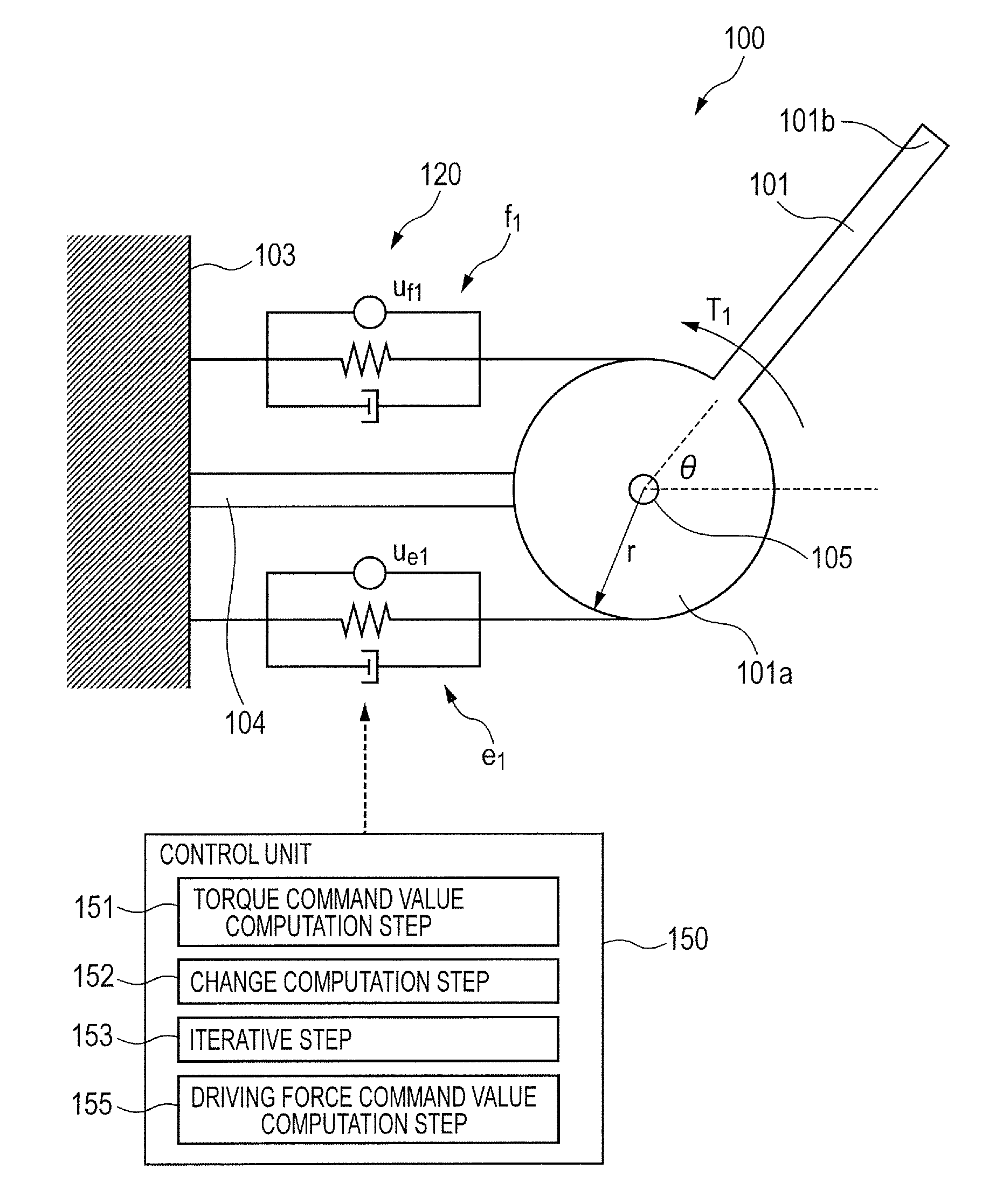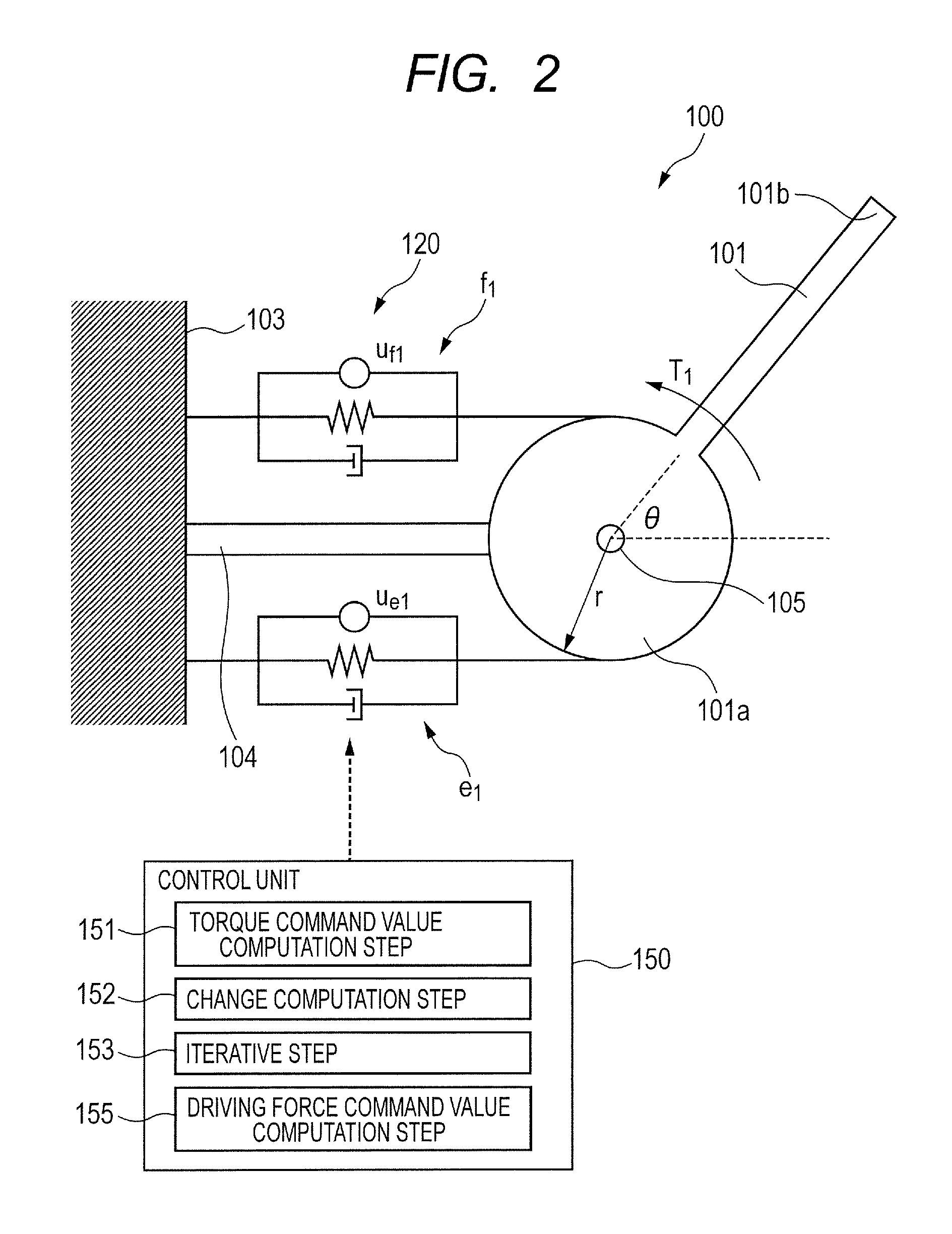Control method of robot apparatus and robot apparatus
a robot and robot technology, applied in the direction of programmed manipulators, programme control, instruments, etc., can solve the problems of reducing the operating time of the robot, the minimum control input of the robot, and the difficulty of controlling the controllability of the artificial muscle actuator, so as to extend the operating time and optimize the stiffness of the joint
- Summary
- Abstract
- Description
- Claims
- Application Information
AI Technical Summary
Benefits of technology
Problems solved by technology
Method used
Image
Examples
first embodiment
[0039
[0040]FIG. 1 is a diagram illustrating a viscoelasticity model of an actuator applied to a robot apparatus according to a first embodiment of the present invention. The present first embodiment describes an example of simultaneous control of a joint angle and stiffness of a joint of a manipulator using pneumatic artificial muscle actuators in a robot apparatus.
[0041](1) Modeling
[0042]The artificial muscle actuator is an actuator with characteristics similar to characteristics called viscoelasticity of muscle. As illustrated in FIG. 1, the artificial muscle actuator is modeled using a force generation element, an elasticity element and a viscosity element. Contractile force of the force generation element is defined as u, and an amount of contraction of muscle is defined as x wherein a contraction direction is positive. The following formula denotes a contractile rate.
{dot over (x)}
[0043]An elastic force constant is defined as k, a viscous force constant is defined as b, and mus...
second embodiment
[0081
[0082]A robot apparatus according to a second embodiment of the present invention will be described. In the present second embodiment, control operation by a control unit is different from the control operation by the control unit of the first embodiment. In the configuration of the main body of the robot apparatus, components with similar configurations as those of the main body of the robot apparatus of FIG. 1 described in the first embodiment are designated with the same reference numerals, and the detailed description is omitted.
[0083]The present second embodiment delivers a two-degree-of-freedom control system merging the feedforward control system illustrated in the first embodiment and a feedback control system. The feedback control system is delivered to allow simultaneously following the target trajectory and the joint stiffness command values obtained by the iterative computation algorithm. With only the feedforward control system, the control performance deteriorates...
third embodiment
[0104
[0105]A robot apparatus according to a third embodiment of the present invention will be described in detail. FIG. 8 is an explanatory view illustrating a schematic configuration of the robot apparatus according to the third embodiment of the present invention. The present third embodiment describes an example of control of hand stiffness of a robot apparatus 200 as a two-link manipulator with three pairs (six muscles) of artificial muscle actuators.
[0106](1) Modeling
[0107]The robot apparatus 200 illustrated in FIG. 8 includes a pulley 203, a first link 201 pivotally connected to the pulley 203 through a first joint 211, and a second link 202 pivotally connected to the first link 201 through a second joint 212.
[0108]The first link 201 is made of a longitudinal member, and a base end 201a of the first link 201 is pivotally supported by the pulley 203 in a plane of an x-y rectangular coordinate system (hereinafter, called “work plane”). The second link 202 is made of a longitudin...
PUM
 Login to View More
Login to View More Abstract
Description
Claims
Application Information
 Login to View More
Login to View More - R&D
- Intellectual Property
- Life Sciences
- Materials
- Tech Scout
- Unparalleled Data Quality
- Higher Quality Content
- 60% Fewer Hallucinations
Browse by: Latest US Patents, China's latest patents, Technical Efficacy Thesaurus, Application Domain, Technology Topic, Popular Technical Reports.
© 2025 PatSnap. All rights reserved.Legal|Privacy policy|Modern Slavery Act Transparency Statement|Sitemap|About US| Contact US: help@patsnap.com



